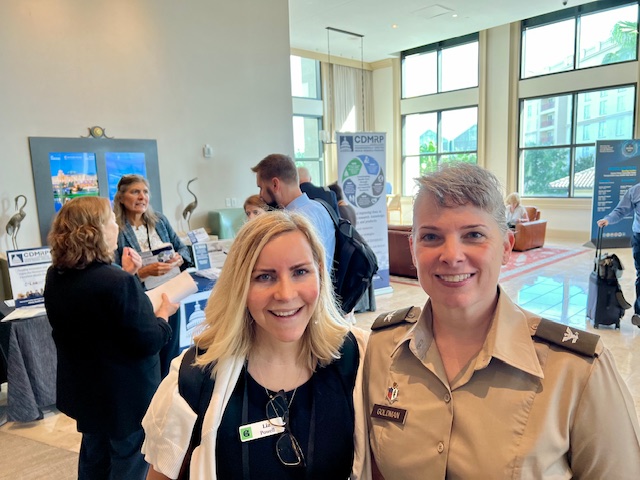MHSRS 2024 DAILY DIGEST – DAY 2
On Day 2 of MHSRS, G2G attended breakout sessions focused on reducing harmful behaviors among service members, pain management, improving traumatic wound healing, reducing infection, and mitigating chronic pain. Regenerative medicine is also a recurrent theme at the conference. We spoke to representatives of the Advanced Regenerative Manufacturing Institute (ARMI) about how they support development of military aligned products in this space at higher technology readiness levels (TRLs). Presentations in this space centered on the skin – including cell therapies to improve the quality of skin at stump sites among amputees to facilitate more comfortable prosthetic placement and new dermal templates to allow for reconstruction of skin across full thickness wounds in a single surgical step.
G2G met with key program managers and leaders military medicine research directorates. This includes the Combat Casualty Care Research Program (CCCRP), the Military Infectious Disease Research Program (MIDRP), the Army Institute of Surgical Research (ISR) and the US Army Medical Materiel Development Activity (USAMMDA). These conversations emphasized that prospective performers looking to bring their military medical products forward must align with military requirements. Part of this process centers on engaging with clinicians at military treatment facilities (MTFs) and medics in the field who are the end users of military medical innovations.
Congressionally Directed Medical Research Program (CDMPR) was a focus for the G2G team today. CDMRP funds impactful, innovative research for specific programs added by Congress to the Defense Appropriations Bill for targeted research to fill gaps and address high-priority needs focused on improving health, well-being, and health care quality for those affected. In FY24, there was $1.509B in funding for CDMRP grant recipients. Top funded research programs other than peer reviewed medical and cancer topics were TBI and psychological health ($175M), breast cancer ($150M), and prostate cancer ($110M). Newly added in FY were arthritis ($10M) and Glioblastoma ($10M).
We talked with outgoing Director Sarah Goldman and incoming Director Mark Hartley about plans for FY24 and FY25. Sarah next heads to the Office of Management and Budget where she will oversee defense health funding within the president’s annual budget. She shared insights on how the OMB process is working between now and January. She also shared the impact of health innovation supporters talking with Members of Congress about the necessity of medical research funding.
As women’s health continues to be a focus, CDMRP funds research on women's health, encompassing a range of diseases and conditions that affect women uniquely, disproportionately, and differently than men including endometriosis, maternal mental health, musculoskeletal injury, and breast, endometrial, ovarian, and thyroid cancers. CDMRP established a policy on the inclusion of women and minorities in clinical research in October 2020, which requires all CMRP-funded clinical research studies to include women and individuals from minority groups, unless there is a clear, justifiable rationale with respect to the health of the subjects or purpose of the research. Beginning with FY25 applications and awards, researchers must consider sex as a biological variable (SABV) in the study design and analysis plan, provide strong justification for proposing a single-sex study, and report sex-based differences and/or disaggregate. This applies to all stages of research – basic, translational, and clinical.
Multiple sessions focused on the role of artificial intelligence (AI), machine learning (ML) and big data and in military healthcare and research. Innovative work in this space is being done in the MHS and by external performers to predict post fracture pulmonary and renal complications, osteoarthritis and sepsis. In the wider military health continuum of care, the anticipated use of AI/ML is focused less on replacing human interfaces with patients, but rather on reducing the need for providers to fulfil repetitive or long-term tasks like notetaking, entering information in a computer or constantly monitoring vital signs indicators. The idea is that with these applications of AI/ML the military health provider will be able to be more attentive to each individual patient, even if the aggregate amount of time is relatively limited. This is expected to be a gamechanger particularly in dispensing mental healthcare to servicemembers.









